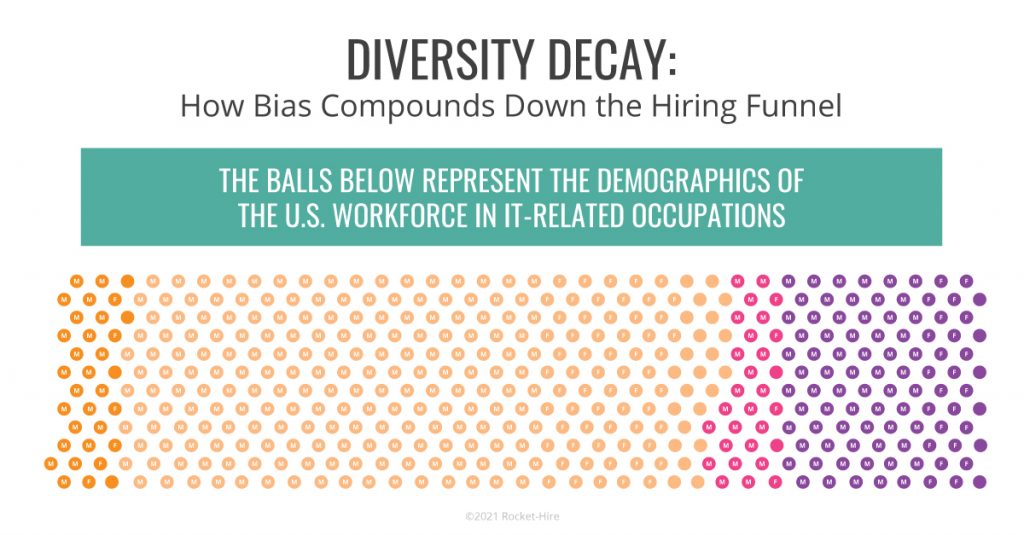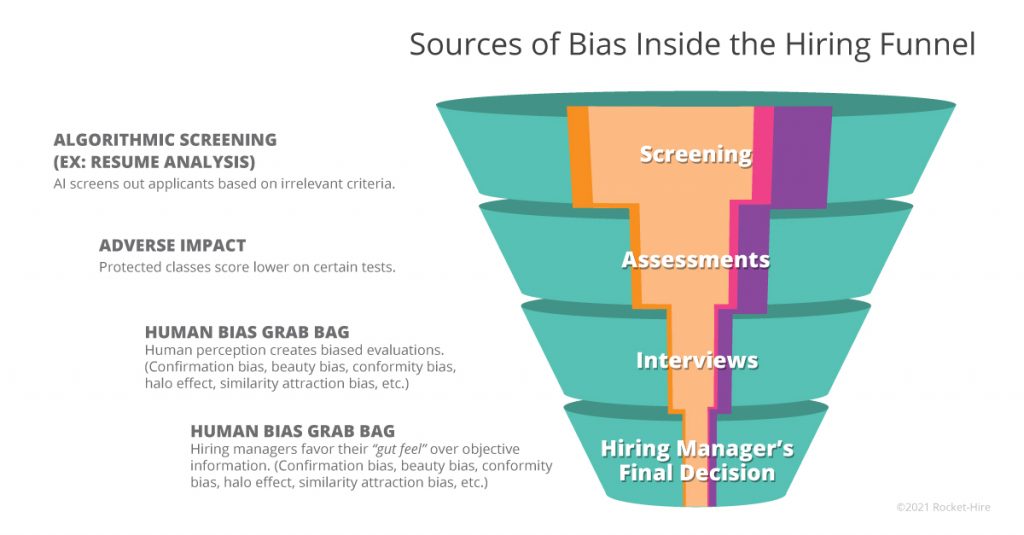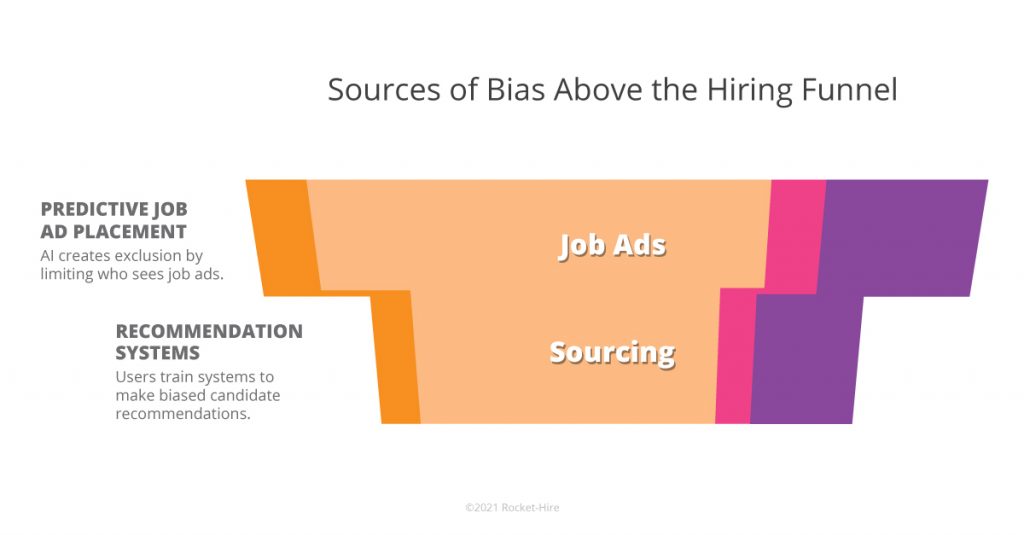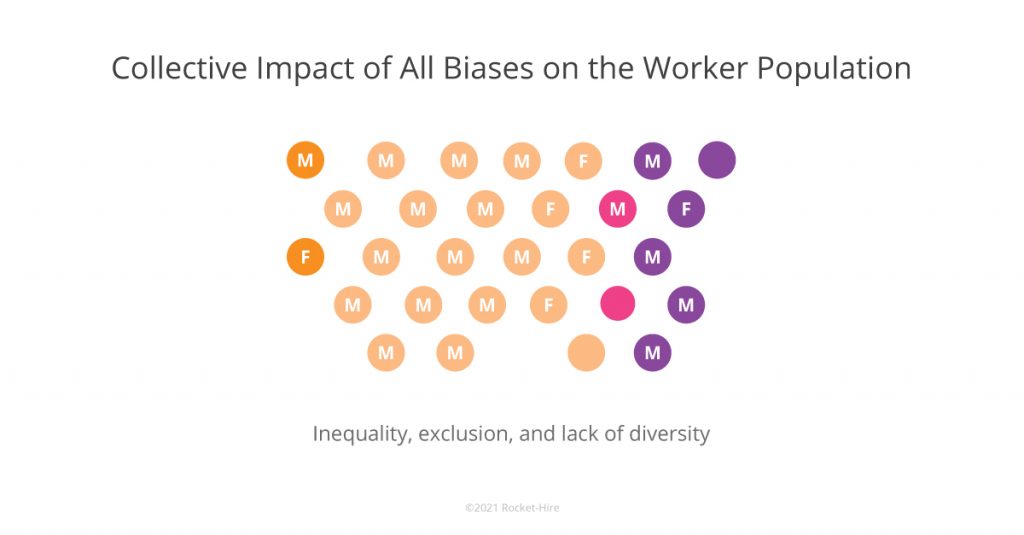Companies know that diversity is important, especially as the markets they serve also continue to become more diverse. For decades, companies have operated under the false assumption that a lack of organizational diversity is a talent pool or pipeline problem. And, with that attitude, companies historically haven’t felt obligated to implement diversity and inclusion recruitment best practices.
But it’s not just a pipeline problem. Society itself is diversifying, and so is minority buying power. Recent research from the University of Georgia’s Selig Center for Economic Growth estimates that, between 1990 and 2020, the combined purchasing power of Black, Asian American and Native American consumers grew from $458 billion to $3 trillion.
Diversity and inclusion recruitment best practices can and will move the needle toward increased workforce diversity. If we don’t look holistically at bias as the compounded result of all the steps in our hiring workflow and take steps to overcome it at each key juncture, our biases will cause any diversity we do have to decay as we move down the hiring funnel resulting in the same homogeneity we’ve cultivated for years.
It’s time to take a stand for diversity by putting the effects of bias in check. Here is an overview of the sources of bias that can contaminate your hiring process and an overview of some inclusive hiring practices to curb diversity decay down your hiring funnel.
Why Diversity Hiring Is Important
Employers across industries have recently renewed their commitment to hiring more qualified diverse talent. And that’s not just a social and ethical imperative: Companies that harness and empower diversity in the workforce simply perform better than competitors that don’t.
According to research from McKinsey, companies in the top quartile for diversity were 36% more profitable than companies in the fourth quartile.
And diversity in leadership matters, too: Research from the Boston Consulting Group found that companies reporting above-average diversity on their management teams also reported higher innovation revenue. These companies reported 45% of total revenue from innovation revenue, on average, compared with only 26% of total revenue reported by companies with below-average leadership diversity.
Bringing diverse talent into your company at all levels is essential to achieving business success.
But bias continues to affect our ability to give diverse talent a fair chance. There’s no simple fix: Unconscious bias is deeply rooted in how humans interpret the world. Our brains constantly receive information and attempt to process it quickly and effectively. That results in generalized judgments about individuals based on identity cues. Add to this the bias baggage that comes with AI powered recruitment ads, sourcing, and screening and you have a real mess on your hands when it comes to the diversity of your workforce.
While we will never eliminate bias, we can implement equitable hiring practices designed to mitigate its effect on hiring decisions.
How to Ensure Recruitment and Selection Processes Are Fair
Before we can overcome the impact of bias, we have to understand how it works to undermine diversity efforts across the hiring process.
Unconscious bias isn’t isolated to one stage of hiring. Bias affects hiring outcomes before we post job openings all the way to the point when we make the formal job offer. Those biases are compounded down the hiring funnel, creating less and less diversity the further down you go.
Truly, hiring for diversity is a matter of probability: You won’t get diversity at the bottom of the funnel if it isn’t sufficiently present at the top. And because our biases lead to diversity decay across the hiring process, we have to work especially hard to achieve diversity above the funnel.
You need to have a clear diversity recruiting strategy to make that happen. But many companies don’t have a diversity hiring plan to ensure diversity above the funnel. According to D&I research from SmartRecruiters, only 21% of companies have defined strategies and processes for setting and calibrating diversity hiring goals. That same research reveals that only 26% of companies have processes in place for monitoring progress towards diversity hiring goals.
But without a strategic plan in place, it’s nearly impossible to obtain the budget and buy-in needed to implement diversity and inclusion recruitment best practices.
However, understanding how diversity deteriorates down the funnel can offer a starting point for developing a strategic diversity hiring process. When you know how bias manifests across recruitment and selection, you can take steps at each point to put your biases in check.
Improve Diversity in Sourcing Above the Funnel
Because achieving a diverse workforce is a numbers game, you need to get the right candidates into the funnel to improve your diversity hiring outcomes. But many of the artificial intelligence tools we use to advertise jobs can undermine diversity at the top of the funnel, where it counts the most.
Predictive job advertisement placement tools can create exclusion by limiting who sees your job ads. Sourcing platforms that deliver ads based on behavior patterns (like the number of clicks on job applications), for example, could direct ads and notices away from demographic groups who are historically less likely to take these actions.
Job-matching/reccomendation platforms can compound that risk because users train systems to make potentially biased recommendations. Rather than showing a woman a range of jobs she’s qualified for but may not look for on her own, for instance, a platform may just show her the types of jobs she’s searched for historically. And if she’s historically only looked for lower-level roles, then the platform creates a self-fulfilling prophecy.
How can you improve recruiting processes to mitigate potential bias above the funnel? Make it a point to source with purpose by taking control of your entire job ad placement process and the communities you advertise your jobs to. Be intentional about targeting candidates at historically Black colleges and universities (HBCUs), Hispanic-serving institutions (HSIs) or minority-focused professional organizations, for example.
To improve diversity sourcing, cultivate strong relationships with diverse talent communities locally through meet ups or through social media and other online platforms. Doing so supports a more authentic and attractive employer brand for diverse job seekers, which can improve diversity at the top of the funnel.
Companies that source strategically and leverage their HR technology to communicate with diverse talent populations see better diversity hiring outcomes. They’re putting enough diversity above the funnel to get diversity at the bottom.
The Boston Consulting Group (BCG) offers a great example. The company intentionally partners with diversity-oriented universities and organizations like Management Leadership for Tomorrow. And the company goes a step further by actively working alongside social justice organizations to improve social equity, giving them greater visibility in diverse communities.
Fair Talent Screening: A Critical Stage in the Diversity Hiring Process
Bias is present down the entire hiring funnel, but talent screening is especially vulnerable. At this stage, recruiters judge candidates based on criteria that are often neither clearly defined nor relevant to performance.
In the absence of clear competency criteria, a recruiter may give an edge to one candidate because they graduated from the same college, for instance. Names are still a source of unconscious bias that damages your diversity hiring funnel.
Candidates with distinctively Black names were 2.1 percentage points less likely to be contacted about their applications than candidates with distinctively white names, according to a study on Systemic Discrimination Among Large U.S. Employers recently released by the National Bureau of Economic Research. By contrast, blind hiring, which scrubs irrelevant personal information such as names, addresses and schools, highlights a candidate’s skills and achievements.
The criteria we highlight and look for in an application could also be contributing to diversity decay.
At the initial resume screening stage, the criteria we select as “good” or “bad” can affect whose applications make it out the other side. A lot of the screening criteria we’ve traditionally used have been working against our diversity hiring efforts. AI compounds the human biases that we program into the algorithm when we set irrelevant screening criteria.
Think about some of your legacy screening requirements. Are they based on a job analysis to actually predict performance, or could your screening criteria be introducing unnecessary bias?
Degrees and a specific number of years of experience are classic legacy requirements, but they could be excluding diverse candidates without adding any value. Having a formal four-year degree, for instance, doesn’t necessarily predict high performance in a particular role.
However, aptitudes toward problem-solving or critical thinking actually can predict performance, if good performance hinges on those qualities.
Requiring a formal degree as part of the selection criteria will automatically kick out resumes for qualified applicants who don’t have a degree — even though a candidate’s educational achievement has little to no predictive validity.
Using arbitrary screening criteria like formal education or experience often leads to increased homogeneity further down the funnel. Candidates with disabilities, for example, may not have a typical or regular employment history simply because they haven’t had the same opportunities that are afforded to able-bodied candidates.
Companies that discard legacy requirements in favor of objective, competency-based criteria can attract a more diverse slate of candidates. Traditionally, the Dutch Air Traffic Control sought out only candidates with university degrees. But the organization recently began integrating pre-hire assessments to screen for a wide variety of important cognitive skills including stress resilience ⏤ a vital trait in the field ⏤ with much better results.
By changing their process the organization lowered their degree requirement from university to high school and managed to improve quality by 140% in total (more selected candidates successfully finishing training and hence starting the job). They ascribe 60% to the pre-hire assessment.
Assessments are a critical tool for combating bias by assessing candidates objectively and fairly.
Update job descriptions to focus on essential criteria that predict performance in the role. You need to determine the human characteristics, skills and aptitudes that impact their performance. Do a systematic review of the position across incumbents, supervisors and leaders. Use what you learn from that review to isolate specific screening criteria for the role. Those become essential criteria that you can measure with assessments, which keeps your screening process more objective. And the more objective your screening and shortlisting processes are, the less likely biases are to affect your decisions.
Finally, if using any AI based screening tools ensure that the vendor is accountable for showing how their tool works and that you base all screening criteria on transparent job related factors. Always conduct a local validation/fairness analysis for any screening tool, AI or otherwise.
3 Examples of Cultural Bias in Assessment
Assessments provide a lot of value to the hiring process. While the assessment industry has been combatting bias in hiring for decades – and has made great strides – nothing is fully immune from bias, and the assessment process is no exception. When deployed poorly and without up front work to identify and reduce bias, assessments can compound human biases at the selection stage. Here are a few ways these problems can show up.
Cognitive Tests Fail to Account for Socioeconomic Status Gaps
Because socioeconomic status can influence performance on cognitive tests, research published in Scientific Reports found, members of protected classes or historically disadvantaged groups may not score as high on some cognitive assessments as their more privileged peers. This can lead to screening out qualified talent from diverse backgrounds and with diverse skill sets — and can lead to lawsuits and legal issues. Cognitive tests are not all bad, but the best practice is to identify complementary predictors that can be added to the mix to reduce the overall bias of the assessment battery. Since reading is one of the main factors of bias in cognitive tests, consider using a cognitive game or other non-verbal measure.
Tests Assume Common Culture and Interpretation
Assessments that rely on understanding cultural touchpoints or expressions can unfairly disadvantage candidates from other cultural backgrounds. Assessment questions can be interpreted differently by individuals from different cultures. Scoring test responses in a way that favors one culture’s norms over another’s can lead to candidates from other cultures being inaccurately perceived as less capable, research on cultural bias in assessment suggests.
Stereotypes Harm Assessment Performance
Negative stereotypes prevalent in the culture can impact performance on assessments. Research shows that when individuals are sensitive to a specific stereotype, they don’t perform as highly as they would if they weren’t sensitive to it. When women were told that a math test was known to show gender differences, they performed poorly compared with women who were told the opposite, research from the American Psychological Association (APA) found.
How to Mitigate Bias in Assessments
Industrial and organizational (IO) psychologists can help identify the right types of assessments to use at this stage and can evaluate assessment vendors for potential risk factors. These experts can help manage bias through several techniques, including local validation and AI studies, and ensure your compliance with the EEOC’s assessment guidelines.
It’s impossible to eliminate bias from the assessment process specifically, and from the hiring process at large. But we can monitor the effects of bias in assessments and manage them to reduce the impact on selection decisions.
Notably, while certain assessments can compound human biases, not using assessments at all leaves you with a process with far more potential for bias to creep in.
How to Reduce Bias in Interviews
The interview stage is highly susceptible to the effects of bias. Interviews are often conducted one-on-one by the hiring manager, but without proper training, it can be difficult to maintain objectivity in that process. During the course of the conversation, especially small talk, interviewers can be swayed by factors that have nothing to do with potential job performance.
In the absence of objective criteria and standardized interview questions, interviewers fill in the gaps ⏤ oftentimes based on their personal opinions and preferences. This creates even more opportunities for bias to cause diversity decay.
Here are some common types of bias affecting the interview process.
Beauty Bias
People who are conventionally attractive have an edge over their peers who don’t meet society’s arbitrary beauty standards. Height in men is correlated with higher income, for example, while obesity in women is correlated with lower income, research from the University of Virginia found. And beauty bias can exaggerate the effects of other biases, too, such as racial or ethnic bias.
Confirmation Bias
When we believe something to be true, we interpret circumstances as supporting our belief, producing confirmation bias. If an interviewer is already enamored with a candidate, they may ask questions that play to their strengths instead of asking standard questions that produce better data.
Conformity Bias
We all have an innate desire to be accepted, which plays out in conformity bias, where an individual will publicly agree with popular opinion even if, privately, they disagree. If you have an interview panel of mostly white men and one woman of color, for example, she may have reservations about a candidate that she doesn’t share because she second-guesses her own opinion or fears her co-panelists’ negative reactions.
Halo and Horns Effect
When a single aspect of a candidate’s resume, appearance or application either enchants us (halo) or puts us off (horns), that colors our perception of the candidate as a whole. If someone has graduated from a prestigious university, for example, the recruiter or hiring manager may assume that the candidate meets the rest of the essential criteria. Conversely, if the candidate has a gap in their resume, recruiters or hiring managers might make negative assumptions about their character and qualifications.
Similarity Attraction Bias
People tend to be more comfortable around others similar to themselves, which can result in a bias toward them. If small talk reveals that an interviewer and a candidate have similar interests, for example, the interviewer may give that candidate an edge over candidates who don’t share that interest. Similarity bias is often thinly veiled as culture fit.
Similarity bias is especially dangerous at the interview stage. If we give the edge to candidates who are most similar to us, we risk passing a primarily homogenous group of candidates further down the funnel.
Slack’s hiring team recognized the impact bias was having on the company’s interview process. They shifted to a standardized interview model, asking each of the candidates for a role the same skill-oriented questions. Interviewers practiced with their colleagues to hone their ability to objective during interviews.
Do You Need Diversity Training for Hiring Managers?
Hiring managers tend to favor their gut feelings — which are usually rooted in biases — over objective information. That’s compounded when we fail to provide a means of assessing candidates objectively and clear, job-related criteria to assess against.
Managers must be trained to treat interview processes as an objective assessment. The goal is to gather predictive performance data from their conversation, not “getting to know” the candidate. Without that objective lens, hiring managers fall back on the extremely subjective “culture fit” to make their final selection decisions.
“Culture fit” is a problematic concept. Because the term is rarely defined, hiring managers fill in the blanks with their own interpretations, inviting bias. Instead, train hiring managers to think about “culture add” when making their final hiring decisions.
When the pool is narrowed down to candidates who have the right skills, competencies and values alignment, discerning hiring managers should give the edge to the candidate who has something different to offer. That could be cognitive diversity (different ways of thinking) or experiential diversity (a unique worldview shaped by unique experiences).
Bias is further compounded down the hiring funnel when hiring managers have a largely homogenous final slate of candidates to select the final candidate from. We need to hand a diverse slate of candidates over to the hiring manager to increase the odds of a final diverse hire.
At Hershey, leaders are held accountable for diverse representation across the entire hiring process. The company sets concrete diversity hiring goals, and the results are tied to their compensation. This signals how seriously the company takes diversity, so managers make it their priority, too.
Adopting Hiring Practices That Promote Diversity
The collective impact of biases across the hiring funnel is increased inequality and exclusion.
The effects of bias are impossible to completely remove, but a holistic approach that begins with a commitment to diversity-focused hiring strategies puts the odds in your favor before you even begin the hiring process. Committing to tracking metrics and outcomes creates a baseline, allowing you to see the impact you can gain from your efforts.
When you’re aware of how bias leads to diversity decay down the funnel, you can take concrete steps to anticipate and overcome it, resulting in a greater chance of diversifying your workforce — and driving better business results.



